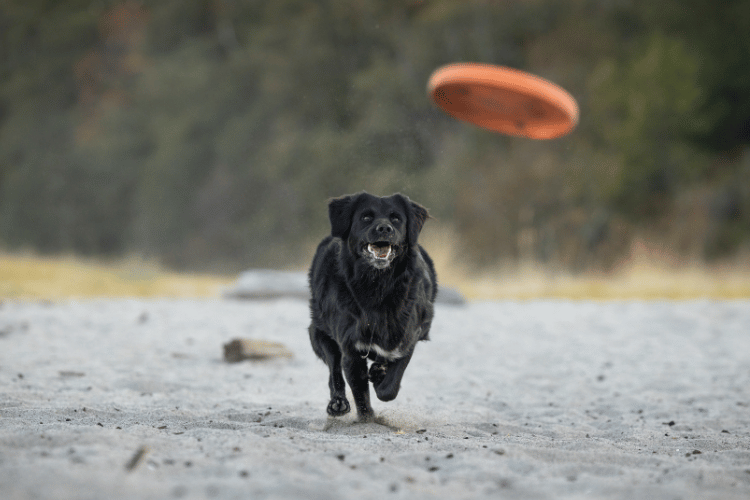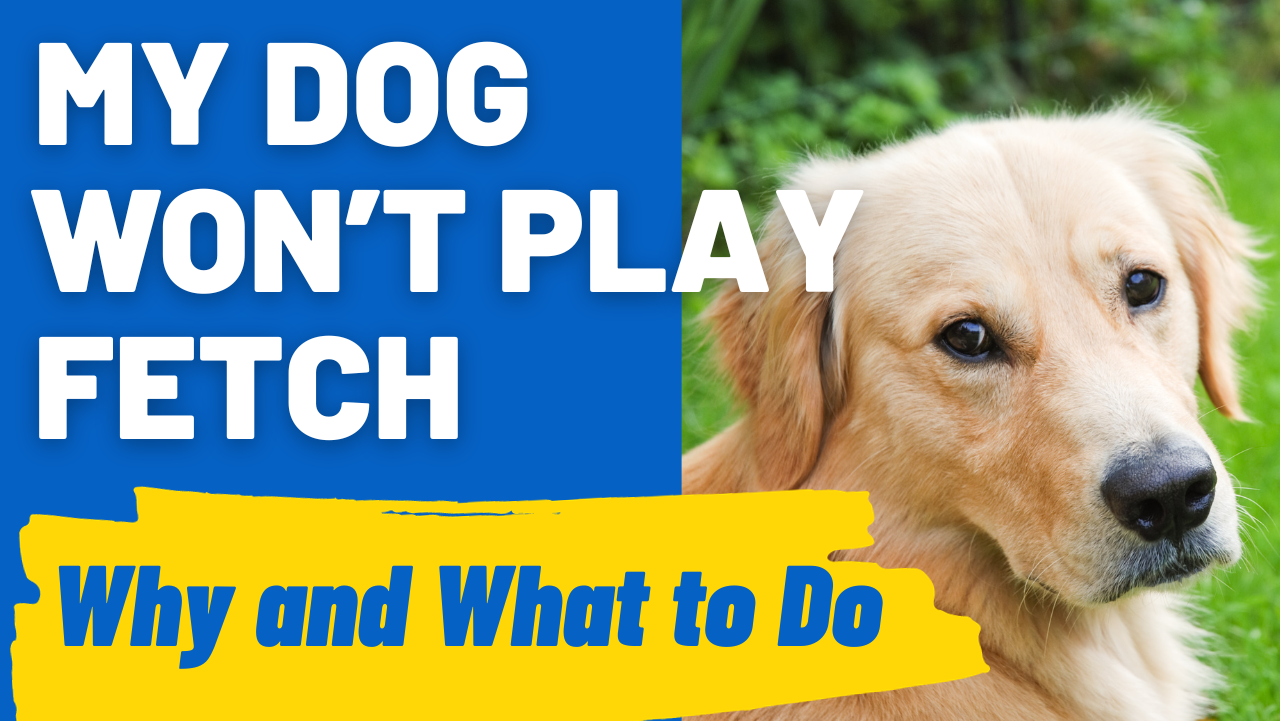Many pet parents tell us, “My dog won’t play fetch. Why don’t they like it and what can I do?” They feel like they’re bad dog parents because they can’t seem to get their dogs to enjoy fetch.
We’re here to tell you that it’s perfectly normal for some dogs not to show interest in the game of fetch. It could be that your dog loved it at one time, but has outgrown it or lost interest. Or maybe they never really got the idea of chasing after toys and balls in the first place.
Whatever the cause, there’s still hope for your dog. In this post, we’ll walk you through some common reasons why your dog is fetch-resistant, and what you can do about it.
Let’s jump in.
Why Won’t My Dog Play Fetch?
We’ve been programmed to think that playing fetch is a favorite activity of all dogs in the world. Yet, just like we don’t enjoy certain types of sports or activities, so do our four-legged friends.
Maybe your dog doesn’t enjoy running after a toy or ball just for the fun of it. It could be they prefer spending their quality time with you doing other types of activities like going for a hike, playing hide and seek, or doing interactive food and toy puzzles.
Another thing to consider is it could be because of an underlying health issue. Is your dog getting older? Do they suffer from stiff joints, arthritis, or other health issues that could be impacting their ability to chase after a toy?
Dog Breeds that Don’t Play Fetch
One possible reason your dog doesn’t want to play fetch is that it’s in their genetic makeup.
So, while some breeds are born with excess energy and an internal drive to run after objects, pick them up, and bring them back. Other breeds are low-energy and more laid-back.
If your dog belongs to one of the breeds that don’t have an inclination for fetch, it doesn’t mean they won’t ever learn how to do it. It simply means they just need a bit of extra training.
Below are some breeds that are terrible at fetch:
- Dachshunds don’t have the attention span for running after objects and bringing them back
- French bulldogs have stubby legs that get in the way when chasing toys
- Border Collies don’t have the grace and speed to run after objects
- Saint Bernards are too patient and calm to enjoy such a fast-paced game like fetch
- Chow Chows are reserved and have a natural desire to not move all that much.
What Age to Teach Puppies to Fetch?
Your puppy is ready to learn how to fetch as early as 2–3 months old. Though, it’s worth noting that if you start this early, you may end up with an adult dog that’s obsessed with the game.
On the other hand, if your dog belongs to a breed that’s not inherently crazy about fetch, to begin with, they may end up losing interest in the game later on in life.
If you prefer, you can always wait a couple of more months until your puppy is six months old. By then, you should be taking them for daily runs in the park and on long walks where you can teach them to bring back various toys for fetch.
How to Teach Fetch to Your Dog?

Some dogs instinctively know exactly what to do once you throw a ball. Others, however, need a bit of guidance to get them not only to chase after the object but to bring it back as well.
With these breeds, teaching them to fetch may take a bit longer, but it’s the perfect opportunity to spend some quality time bonding with your pup and get them to exercise more.
One of the more effective ways to teach your dog to fetch is to use the bait-and-switch method. Using two balls, throw the first one and keep the second one in your hand. When your dog reaches the first one, use the second toy to entice them to come back.
Whether they return with the first toy or not, throw the second one just the same. Then, pick up the first one as your dog reaches for the second.
Repeat this until your dog understands that they have to run back to you with the toy. Once they catch on, you can start introducing certain commands like ‘fetch,’ ‘bring it,’ and ‘drop it,’
Here are some more expert tips to help you when training your dog how to fetch:
- Use a specific cue word each time you throw the object to teach your dog what’s expected of him with each command.
- Run with your dog and stop when you reach the object.
- Reinforce good behavior with praise, hugs, and treats.
- Some dogs will chase after the object and fetch it, but won’t let you have it back, so make sure they hand it over by using commands like ‘drop it’ or ‘give.’
- End the game before your dog loses interest so they’ll look forward to playing again the next day.
What to Do When Your Dog Won’t Fetch?
Some dogs that won’t fetch often have one of three reactions to the game.
One, is they have no interest at all in chasing after an object. They just sit there and watch it fly overhead.
The second reaction is that they love running, so going after a toy is no problem for them. They just don’t want to pick it up or bring it back.
Finally, some dogs are great at chasing after the toy and picking it up, but they don’t like releasing it. They’ll settle for chewing on it or just playing by themselves.
If any of these sound familiar, it could be that your furry friend hasn’t been taught to fetch. Another reason is that they just don’t see the point in the game because they haven’t been given the proper motivation to do any of these steps.
Luckily, there are plenty of things you can do to encourage your dog to become excited at the idea of fetching, retrieving, and letting go.
Start by choosing a fetch toy that piques your dog’s interest. Rather than going for a regular tennis ball, why not get them a different type of fetch toy or a ball made of a different texture or size?
Next, tap into their innate desire to chase. If your dog belongs to a lazy, easy-going breed, keep the toy only a foot or two away to get them eager to go after it.
When they reach it, give them a treat and a big hug. Make them sense your excitement and how proud you are of what they’ve accomplished.
After repeating a couple of times, it’s time to start teaching them common fetch commands. Remember to praise and reward each time to encourage them to get the toy and bring it back to you.
You might be interested in this post if it’s relevant to your situation: My Dog Won’t Use the Dog Door: Why and What to Do
How Do You Get a Stubborn Dog to Fetch?

If your dog seems to be acting out and being stubborn, it could just be their way of showing you they need more stimulation and encouragement to do what you want them to.
So, if your dog is determined not to fetch, here’s one way to lure them into it:
- Pick out a good fetch toy, introduce it to your dog, and let them sniff it.
- Place the toy beside you. As your dog approaches the toy, praise them by clicking or saying ‘yes!’ and give them a training treat.
- Increase the excitement around the toy by moving it around on the ground or playing a game of tug with it.
- Next, hold the toy at arm’s length at different positions and encourage your dog to touch it.
- After that, start leaving the toy on the ground, but still at arm’s length.
- Then, each time your dog interacts with the toy with their mouth rather than just their nose, praise and reward them.
- When they begin to pick it up with their mouth, click, give out treats, and act like it’s the most wonderful thing they’ve ever done.
- Begin throwing the toy only a few feet away from you and encourage your dog to bring it back. Don’t forget to praise and reward each time.
- If you prefer adding a verbal cue to the game, like ‘fetch,’ now is the time to do it.
- Once your dog realizes that they get a treat every time they bring the toy back, you can gradually start to increase the throwing distance.
- Finally, take your fetch game outdoors, and don’t forget to bring along some treats.
In Conclusion
Some dogs may never learn to enjoy the game of fetch. You can always train them to retrieve a toy or a ball, but they just don’t seem that into it.
If that’s the case with your furry friend, have no fears. There are plenty of ways to spend quality time with your dog.
Try introducing your dog to other games and activities that provide them with the physical exercise and mental stimulation they need to live a long and healthy life.





